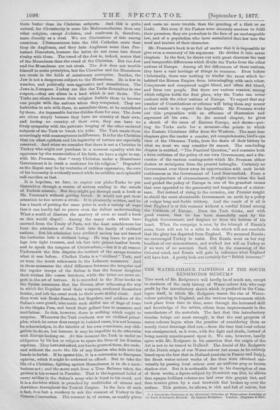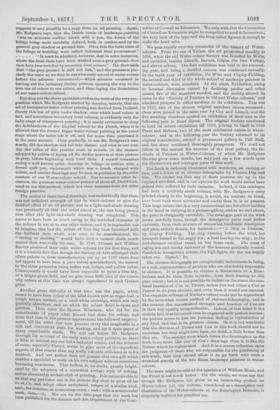THE WATER-COLOUR PAINTINGS AT THE SOUTH KENSINGTON MUSEUM.*
Tins work of Mr. Redgrave's will hardly be of much use, except to students of the early history of Water-colour Art, who may profit by the introductory sketch which is prefixed to the Cata- logue itself, in which Mr. Redgrave traces the rise of Water- colour painting in England, and the various improvements which took place from time to time, some through the increased skill and knowledge of the artists, others from improvements in the manufacture of the materials. The fact that this introductory treatise brings out most strongly, is that the real progress of water-colours began when the practice of considering them as merely tinted drawings died out,—from the time thatiocal colour was amalgamated, as it were, with the light and shade, instead of being merely superimposed upon it, We can, however, hardly agree with Mr. Redgrave in his assertion that the origin of the Art is not to be traced to Holland. The denial of Mr. Redgrave of the Dutch origin of our Water-colour Art seems to be entirely based.upon the fact that in Holland (and also in France and Italy),, the finest water-colour works of the time were obtained uni- versally by passing local colour over an uniform grey or brown shadow-tint. But it is noticeable that in his description of one of these works, a figure-subject by Dominich van Del, he allows that opaque brilliant colours are laid over this greyish tint, and then texture given by a cool brownish tint broken up over the surface. This picture, he allows, is rich and full of colour, but * .A Descriptive Catalogue of the Historical Collection of Water-colour Paintings at the South Kensington Museum. By Samuel Redgrave. Loudon: OMmman.&
suggests it may possibly be a copy from an oil painting. Again, Mr. Redgrave says, that the Dutch mode of landscape-painting was an accurate outline drawn with a pen, the forms of the foliage being most carefully defined, both in outline and by the general grey shadow or ground-tint. Over this the local tints of the foliage or building were rather indicated than pronounced."
"It must be admitted, however, that in some instances, where the local tints have been washed over- a grey ground, these tints have been enriched by secondary local colours." He then, adds that "the grey. ground is still not lost," and the- process is pre- cisely the same as we find in our own early school of water-colour before the advance commenced,—which advance consisted in leaving out the initiatory tinting process, opening the way to the true use of colour to our artists, and thus laying the foundation of our water-colour school.
But does not the above quotation confess the truth of the very pro- position which Mr. Redgrave started by denying, namely, that the art of transparent water-colour painting was derived from Holland. Surely-this use of grey under shadow, over which local colour is laid, and sometimes secondary local colours, is evidently only the baby-stage of transparent painting ; it is surely erroneous to deny the indebtedness of the English school to the Dutch, when it is allowed that the former began water-colour painting at the exact stage where the latter left it off, and for some time practised- it in the same manner. Only gradually, to use Mr. Redgrave's own words, did the shadow-tint fall into disuse; and even in our own day the relics of this practice seem to remain, in the manner adopted by artists of laying all the darker portionof their picture in grey, before beginning with local tints. I myself remember seeing a well-known artist, drawing in foliage in outline with a broad quill pen, underneath which was a brush charged with colour, and similar drawings may be seen in profusion by the elder masters of our Water-colour school. Not to mention other in- -stances, the greatest water-colour painter of them all, David Cox, used to use this method, which is a clear remnant from the older foreign practice.
The notion of these tinted drawings, was undoubtedly that there was not sufficient strength of tint in water-colours to give the finished effect of an oil picture, and so a light-and-shade drawing was practically all that the artist aimed at, the tint being passed over after this light-and-shade drawing was completed. This aeems to have been as much owing to the wretched character of the colours in use as to any other reason,, and it is impossible not to imagine, that had the artists of that day been furnished with the brilliant tints which were soon to be manufactured, the "tinting or staining" would have died a natural death much -sooner than was really the case. In 3780, Thomas and William Reeves produced their cake water-colours for the first time, and it is a curious fact that though the Society of Arts adjudged their silver palette to these manufacturers, yet up to 1783 there does not appear to have been a pure colour manufactured; the nearest to the three primaries being indian red, indigo, and' yellow ochre. COusequently it would have been impossible to paint a blue sky, or a bright-green field, and we gain some little idea of the reason why nature at this time was always reproduced in such Quaker guise.
A.nother great difficulty at that time was the paper, which seems to have been either of the kind known now as sugar-loaf, a rough brown surface, or a hard white cartridge, which was only partially absorbent, and on which the colour dried in spots and patches. Then came the Messrs. Whatman, who did for the manufacture of paper what Reeves had done for colour, and from that time to the present improvement has followed improve- ment, till the artist can now procure every tint imaginable in a soft and convenient state for working, and lay it upon paper of every conceivable shade. We will not follow Mr. Redgrave through his account of the early water-colour painters, as there is little to interest any one but a technical reader, and the account of some, especially Turner, seems to give more of the superficial aspects of that master than any really, valuable criticisms as to his method. And our author does not possess that rare gift which enables a specialist to write on his own subject without sometimes becoming wearisome. This tedium is, no doubt, greatly height- ened by the adoption of a somewhat archaic style of writing, and an abominably archaic style of printing.. his inconceivable to un that any publisher can in the present day elect to print all hie 4 as f's, and adopt other antiquated usages of a similar kind, such, for instance, as connecting every c and t with a semicircular
mark, We see by the title-page that the work has been published for the Science and Art Department of the Coin- mittee of Council ou Education. We only. wialethat the Committee of Council on Education might be compelled to read it themselves ; the very look of the type and the long,tailed figures, is enough to make the head ache.
We pass rapidly over the remainder of the history of Water- colours. From the rise of Turner, the art progressed steadily to 1804, when the old Water-colour Society was founded by Wells, and included, besides himself, Barrett, Gilpin,, the two Varleye, and eleven others, The. first exhibition was held in the succeed- ing year, and being a decided success was continued annually. In the tenth year of exhibition, De Whet and Copley Fielding, the second and third of the whole school of landscape painters in water-colours, -were members. At the ninth Exhibition, owing to internal dissension caused by declining profits and other causes, five of the members seceded, and the society altered its name to the "Society of Painters in Oil and Water-colours," and admitted pictures in either medium to its exhibition. This was in 1813, and of the sixteen original members. eleven remained ; these were joined in the same year by Cox and Linnell, and the five seceding members opened, an exhibition of their own in the following year in Bond Street The original Society continued to hold its mixed exhibitions till 1822, joining to itself in 1820 Prout and Robson, two of the most celebrated names in water- colours ; and in the following year the Society returned to its original constitution,, erected a permanent gallery in Pall Mall, and has since continued thoroughly prosperous. We need. not follow in like manner the account of the rival gallery, the In- stitute of Painters in Water-Colours, of which Mr. Redgrave likewise gives some details, but may just say a few words upon the illustrations and catalogue parts of this work.
The book is variously illustrated with woodcuts, an etching or two, and a dozen or so cbronio-lithographs by Vincent Day and Son. We cannot say that any of these pictures are up to the required standard, and in our opinion the work would rather have gained than suffered by their omission. Indeed, if this catalogue had been a modestly small volume, with Mr. Redgrave's essay printed clearly in the beginning, it would, we venture to think, have been both more attractive and useful than it is at present. This largo octavo size is a very inconvenient one for either holding in the hand or carrying, to a picture-gallery, and.as we said above, the-print is designedly execrable. The catalogue part of the work seems carefully done, though the descriptive parts read rather curiously, from their mixture of somewhat bombastic description aud plain artistic details, for instance :—" A Ship in Distress,' by Copley Fielding. The ship running before the wind, her bowsprit buried in the angry sea ; a boat leaving the ship ; in the mid-distance another vessel. on her beam-ends. The mass of raging sea and murky darkness of the heavens poetically treated. Painted in transparent colour, the high lights on the sea largely taken out. Signed," &a.
The chromo-lithographs are exceptionally unfortunate in being, as a rule, representative of painters who are absolutely impossible to chromo. It is possible to. chrome a Richardson or a Row- botham and do them little injustice, from their leaning to thin pure colour ; but it is not possible to imitate on the stone the con- fused beauties of Cox or Turner, unless you had either a Cox or Turner to do your chromo, and even then it would not succeed. The exquisite softnese,of Turner's colour could not be reproduced by the somewhat coarse method of chromo-lithography, and in like manner the unrestrained strength and freedom of Cox are in their way equally unreprod.ucible. Indeed, of this latter it is a curious fact that he cannot even be engraved with perfect success; the picture seems to lose his personal feeling in reproduction of any kind, and that is its greatest charm. So it is not wonderful that the chromos of Turner and Cox in this work should not be successes, but they might have been, we think, a little better than they are. The smudgy mess which forms. the frontispiece to the book. is no more like one of Cox's drawings than it is like the Nature which he represented. And it is a severe reflection upon the judgment of those who are responsible for the publishing of this work, that they should allow. it to go forth with such a wretched parody of the two finest. landscape painters in water,.
colours.
The same might be said of the specimen of William Hunt, and the Prout is not much better. On the whole, we must say that though Mr. Redgrave has given us an interesting preface on Water-colour Art, the volume, considered as a description and illustration of time Water-colours at the Kensington Museum, is singularly unfitted for practical use.































 Previous page
Previous page